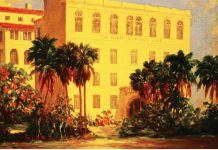LnS GALLERY continues its third Season of the Arts with the solo exhibition Carlos Alfonzo: Witnessing Perpetuity presented from February 15 to April 18, 2020 at 2610 SW 28th Lane in Miami. Collaborative research and a strong community-based passion for the work of Alfonzo – an important historical creative pioneer and key contributor to Miami’s role as a center of artistic force – have realized an exhibition that embodies a comprehensive chronology of artistic evolution in works spanning from 1976-1990. A 78-page hardcover catalog including an essay by Julia Herzberg, PhD, expert on the artist, accompanies the exhibition.
“It is with reverence and intention, that our 5,000 square foot gallery space will be dedicated in its entirety to this exhibition, aligning to commemorate what would have been the year of Alfonzo’s seventieth birthday,” said LnS GALLERY co-founder Sergio Cernuda.
In July of 1980, Carlos Alfonzo left Cuba in exile through the port of Mariel and arrived in Miami. At an early age, Alfonzo’s raw creative talent became apparent, an endowment he began to cultivate through formal artistic studies at the prestigious San Alejandro Academy and at the University of Havana from 1969 to 1977. As a young man living and working within the Cuban communist system, he sought freedom from the limitations he faced, both artistically and personally, under the regime’s restrictive climate. Paradoxically, Alfonzo made the decision to leave Cuba just 8 months before the opening of the pivotal Volumen 1 (Volume 1) exhibition that heralded a new international direction in contemporary Cuban art, and where Alfonzo was slated to exhibit among those who would later become known as the “1980s generation.”
Alfonzo’s style developed significantly and his career as an artist matured during a period in which neo-expressionist figurative art came to renewed global attention. As he was exposed to great works of modernist and contemporary art in America, he internalized a variety of styles – cubist, surrealist, expressionistic, and abstract expressionist – and adapted them to his free-flowing expression resulting in a style discernibly his own. The works are an intense autobiographical experience with cross-cultural mythologies in an oeuvre laden with penetrative, intimate messaging that recounts the soul and struggle of the artist’s life experience through a stark, resonant system of forms. Alfonzo employs the spiritual iconography of African deities, Catholicism, and the ritualistic emblems of Santería. Carlos Alfonzo emerged not simply as a Cuban artist, but rather as a celebrated artist of the Americas.
In the essay accompanying Carlos Alfonzo: Witnessing Perpetuity, Julia Herzberg, PhD, observes the trajectory of the artist’s development, observing that “Alfonzo had his own subjective story, one that viewers will decipher. He said that he was not interested in narrative or anecdote. Rather, his interests lie in expressing a poetic, mysterious quality even though there are [at times] specific themes he unwinds.”
During his lifetime, Carlos Alfonzo realized notable achievements including a Visual Artist Fellowship in Painting from the National Endowment of the Arts in Washington D.C. and a CINTAS Fellowship in the Visual Arts. When the artist’s life was tragically claimed by an AIDS-related illness at the young age of 40, he had just been selected as one of “Ten Artists to Watch in the 1990s” by ARTnews magazine. In the spring of 1991, just one month after his death, a number of his paintings were exhibited in the renowned Whitney Biennial of Contemporary American Art in New York. Today, his work forms part of the permanent collections of the Whitney Museum of American Art, the Hirshhorn Museum and Sculpture Garden, the Smithsonian American Art Museum, and numerous institutions of worldwide prominence.
Recent years have seen major developments for the artist and his work: Told, (1990) by Alfonzo was exhibited in Fast Forward Painting of the 1980s at the Whitney Museum of American Art, and was featured as one of the highlighted works in leading art critic Roberta Smith’s New York Times review of the show. A Tongue to Utter and Ballerinas have been rejoined more than 25 years after first being displayed together at the Lannan Museum in 1989; this mise en scène is now on prominent view at the Lowe Art Museum in Coral Gables, FL. Carlos Alfonzo was also included in the historic exhibition About Face: Stonewall, Revolt and New Queer Art, curated by Jonathan David Katz at WRIGHTWOOD 659 in Chicago, marking the 50th Anniversary of the Stonewall Riots. Additionally, Alfonzo was the subject of a three-artist show at the Sheldon Museum of Art in Lincoln, Nebraska, titled Unquiet Harmony: The Subject of Displacement, organized by Director and Chief Curator, Wally Mason. The increasing interest for the artist is evidenced by these exhibitions and the strengthening valuation of the artist’s market.






